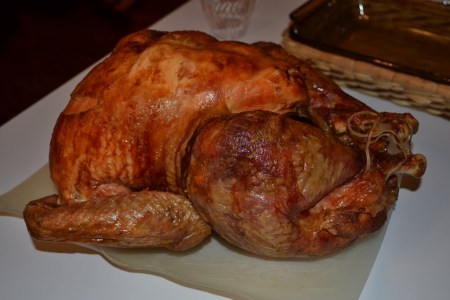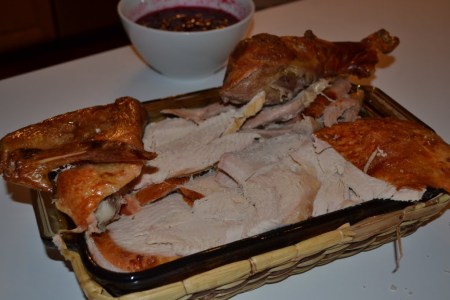I hope everyone had a great Thanksgiving. While I ate dinner at a friends’ house, I still ended up cooking my 22-lb turkey. Though a little miscommunication meant that we didn’t have gravy, fortunately we did have cranberry sauce. While Chris Kimball has quite a few recipes for Roasted Turkey, they all boil down to one basic choice; to brine, or not to brine. Brining will help to ensure the chicken is moist and flavorful, but at the expense of a crispy skin. Because I wanted a beautifully roasted bird, I chose not to brine.
Chris Kimball’s secret to perfectly rendered skin requires two extra steps. First, loosen then skin from the breast and legs. Use your fingers to work skin free, taking extra care not to tear the skin. Using kosher salt under the skin performs the same basic function as brining, but won’t turn the skin flabby. Second, while the turkey is roasting breast side down, line the back with sliced salt pork. The salt pork will provide constant basting during the initial few hours of cooking, and provides some extra flavor. This falls under the theory that bacon makes everything better.
Final results were 4-stars. The meat was a little dry, mostly because of the logistics of finishing the turkey at 4pm, for a 6pm dinner. But it was flavorful, and the skin was perfectly crisp. However, I have noticed that the Thanksgiving crowd is generally a very forgiving bunch. The festive mood glosses over any imperfections, and by dinnertime a few glasses of wine makes everyone even happier.
Rating: 4-stars.
Cost: $1.50, because the turkey was free.
How much work? Low/Medium.
How big of a mess? Low/Medium.
Start time 11:00 AM. Ready at 4:00 PM.
Chris Kimball’s original recipe is here. The descriptions of how I prepared the recipe today are given below:
1 turkey (22 pounds),
3 tablespoons + 2 teaspoons kosher salt
2 teaspoons baking powder
12-oz salt pork
- One or two days before your dinner, remove the giblets and neck and set aside for making the gravy. Use your fingers to separate the skin from the turkey meat on the breast, legs, thighs, and back. Be careful not to tear the skin. Evenly rub 1 tablespoon kosher salt inside the cavity, 1-1/2 teaspoons under the skin of each breast, and 1-1/2 teaspoons under skin of each leg.
- Use plastic wrap to tightly cover the turkey. Place on rimmed baking sheet and put on lowest rack of refrigerator for between 24 to 48 hours.
- Combine 2 teaspoons kosher salt and 2 teaspoons of baking powder in a small bowl. Unwrap turkey and use paper towels to dry inside/outside of turkey.
- Use a metal skewer to poke the fat deposits 5 times for each breast and and each thighs; a total of 20 times.
- Sprinkle the entire skin with the salt/baking powder mixture and use your hands to work into skin. Fold the wings back and tuck underneath the turkey.
- If you are going to stuff the turkey, line the cavity with cheesecloth and put 4 to 5 cups of stuffing inside, then tie the cheesecloth closed using kitchen twine. Also, use kitchen twine to tie the legs.
- Remove the rind from your salt pork, rinse and cut into 1/4″-thick slices. Place the turkey breast-side-down in a V-rack, and lay the slices of salt pork over the back of entire turkey.
- Roast at 325-degrees for between 2 and 4 hours; depending upon the size of your turkey; until an instant-read thermometer reads 130-degrees in the thickest part of the breast.
- Remove from oven and increase oven to 450-degrees. Discard the spend salt pork, and pour the drippings from the roasting pan into a fat separator, which you can use for the gravy.
- Use clean kitchen towels or wads of paper towels to flip the turkey. Cut twine binding legs and remove stuffing bag.
- Return the turkey to oven and cook for between 45 minutes and 1-1/2 hours until the breast registers 160-degrees, and the thigh registers 175-degrees. Rotate the pan halfway through cooking. When the skin turns golden brown and crisp, transfer to a carving board and let rest for 30 minutes.
- Carve turkey and serve.



Your comment that a brined bird would have trouble getting a crispy skin surprised me. I’ve been brining according to the methods I found through Cooks Illustrated, but cooking the bird with a hybrid of CI and Alton Brown methods (basically taking the bird out of the brine, paper-toweling it dry, letting it sit to air dry for, oh, 15-20 minutes, massaging it with canola oil, then cooking it upside down with feet in the back of the oven for an hour or so, then flipping it over–feet still in the back–and cooking until the internal temp hits the right mark).
The only skin I’ve ever had crispier is when my uncles convinced the rest of us to deep fry the birds one year.
Maybe Chris Kimball is blowing the impact of brining out of proportions, but he consistantly says that the added water from brining makes the skin flabby. I brine about half the years, mostly because my Turkey hasn’t completely defrosted and the brining will finish the defrosting. And while brined skin comes out fine (I disagree when he says flabby), but I agree with him that his salting/salt pork technique produces the best skin I’ve ever had, though I doubt I will ever deep fry a turkey.
I’m not sure what the Alton Brown method is. I’ll google it.
Mark